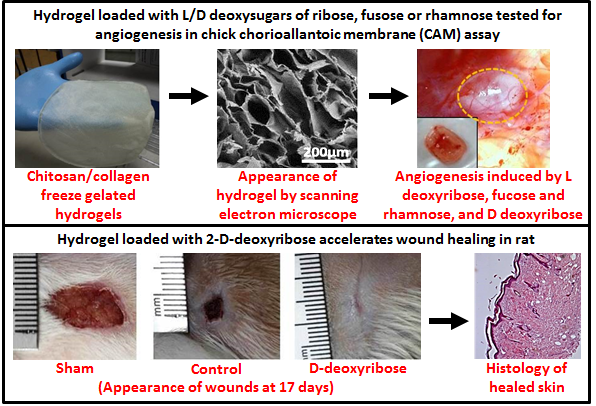Breakthrough collaborative research which shows sugars can be useful!
Throughout the world as people live longer they unfortunately experience an increasing incidence of non-healing skin wounds associated with age, poor blood supply and diabetes. These are difficult to treat for the patients and clinicians and very expensive for healthcare systems to manage.
A new technique, conceived and developed by a collaborative research group from The Department of Materials Science and Engineering and Dental School at The University of Sheffield and the Interdisciplinary Research Centre in Biomedical Materials Research at COMSATS Institute of Information Technology (CIIT Lahore) in Pakistan, promises to aid wound healing, meaning patients would need less treatment, clinicians could treat more patients, and significant savings would be realised by national healthcare systems.
In very basic terms, researchers looked for a simple and cost-effective way of stimulating new blood vessel formation (angiogenesis) that does not involve the use of costly and unstable growth factors. They found that a group of sugars was able to achieve this and hence stimulate wound healing in a skin wound model.
Dr Muhammed Yar from IRCBM made the initial discovery in his work to understand how tumours stimulate new blood vessels. He found that a D isomer of a small deoxysugar was increased when tumours ‘ordered’ new blood vessels to be made. Working with Prof Sheila MacNeil and Prof Ian Douglas, this team then investigated the ability of a group of sugars (in both L and D isomer forms) to stimulate new blood vessel formation in a chick model and to stimulate wound healing in a skin wound model.
While previous work has demonstrated that biomaterials known as vascular endothelial growth factors (VEGF) indeed stimulate angiogenesis, in practice, when used on its own, VEGF is rapidly broken down, diluted or washed away.
In this work, a simple stable and inexpensive D isomer sugar is added to a hydrogel bandage and shown to stimulate new blood vessel formation in a chick bioassay and to stimulate new blood vessel formation and wound healing in an animal model.
This work opens the door to developing simple robust low-cost dressings that can be used to treat poor-healing wounds, such as chronic ulcers in the elderly and diabetic ulcers.
This technique is so significant that it has been protected by a patent held jointly by the University of Sheffield and COMSATS Institute of Information Technology.
The paper “Deoxy-sugar releasing biodegradable hydrogels promote angiogenesis and stimulate wound healing”Muhammad Yara,*, Lubna Shahzadia, Azra Mehmoodb, Muhammad Imran Raheema, Sabiniano Románc, Aqif Anwar Chaudhrya, Ihtesham ur Rehmana, C.W. Ian Douglasd, Sheila MacNeilc,* has been published in Materials Today Communications. http://www.sciencedirect.com/science/article/pii/S2352492817302581

For more information please contact:
Dr. Muhammad Yar, Interdisciplinary Research Centre in Biomedical Materials, CIIT Lahore
Tel: 042111001007 Ext: 868, Email:drmyar@ciitlahore.edu.pk
Prof Sheila MacNeil, Department of Materials Science and Engineering, The University of Sheffield. Tel: 0114 222 5995, Email: s.macneil@sheffield.ac.uk